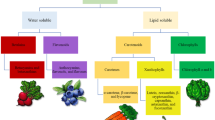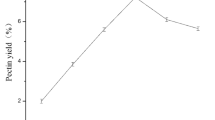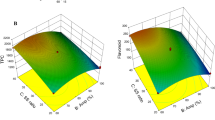Abstract
Extract of purple sunflower hulls is a potential red food colorant; however, suitable process conditions must still be identified. Selected process variables were studied using bench-scale units to prepare, clarify, concentrate and spray dry extracts. Concentration by evaporation at 32°C and addition of maltodextrin to 15% (wt/dry wt) prior to drying largely eliminated pigment degradation during those steps. Relative to water extracts, extracts prepared with 5 to 15% ethanol in water generally yielded more pigment with similar levels of degradation and loss during subsequent processing. Use of 5% ethanol/2% citric acid reduced yield by about half relative to water, but gave a powder with a lower degradation index and wetting time. Percentage recovery of pigment during concentration and drying was not greatly affected by solvent type or extraction temperature.
Similar content being viewed by others
References
Pifferi, P.G., and V. Ortolani, U.S. Patent 4,156,077 (1979).
Francis, F.J.,Crit. Rev. Food Sci. Nutr. 28:273 (1989).
Vaccari, A., P.G. Pifferi and G. Zaccherini,J. Food Sci. 47:40 (1981).
Golz, J.T., D.L. Helgeson, D.F. Zetocha and T.A. Petry, Preliminary Economic Feasibility of Processing a Natural Red Food Colorant from Purple-Hull Sunflower in North Dakota, Agr. Econ. Rep. No. 273, N.D Agricultural Experiment Station, 1991.
Wiesenborn, D.P., Z. Zbikowski, A. Glowacki and N. Hettiarachchy,Trans. ASAE 37:515 (1994).
Mok, C., and N.S. Hettiarachchy,Food Sci. 56:553 (1991).
Perry, R.H., and C.H. Chilton,Chemical Engineers’ Handbook, 5th edn., McGraw-Hill, New York, 1973.
Martin, P.F., M.S. Thesis, Sunflower Hull Anthocyanins: Optimal Extraction Conditions and Selected Stability Characteristics, North Dakota State University, Fargo, 1987.
Holm, E.I.T., Ph.D. Dissertation, Extraction and Characterization of the Pigment in Purple-Hulled Sunflower, University of Minnesota, St. Paul, 1987.
Main, J.H., F.M. Clydesdale and F.J. Francis,J. Food Sci. 43:1693 (1978).
Wiesenborn, D.P., A. Glowacki, N. Hettiarachchy and L. Zander,Trans. ASAE 36:1411 (1993).
Wrolstad, R.E., Color and Pigment Analyses in Fruit Products. Station bulletin 624, Agricultural Experiment Station, Oregon State University, Corvallis, 1976.
Fuleki, T., and F.J. Francis,J. Food Sci. 33:78 (1968).
Niro Atomizer,Analytical Methods for Dry Milk Products, 4th edn., Copenhagen, 1978.
Markakis, P.,Crit. Rev. Food Tech. 4:437 (1974).
Pifferi, P.G., and A. Vaccari,J. Fd. Technol. 18:629 (1983).
Author information
Authors and Affiliations
About this article
Cite this article
Wiesenborn, D., Zbikowski, Z. & Nguyen, H. Process conditions affect pigment quality and yield in extracts of purple sunflower hulls. J Am Oil Chem Soc 72, 183–188 (1995). https://doi.org/10.1007/BF02638897
Received:
Accepted:
Issue Date:
DOI: https://doi.org/10.1007/BF02638897




